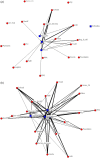Public health systems: a social networks perspective
- PMID: 19686252
- PMCID: PMC2758409
- DOI: 10.1111/j.1475-6773.2009.01011.x
Public health systems: a social networks perspective
Abstract
Objective: To examine the relationship between public health system network density and organizational centrality in public health systems and public health governance, community size, and health status in three public health domains.
Data sources/study setting: During the fall and the winter of 2007-2008, primary data were collected on the organization and composition of eight rural public health systems.
Study design: Multivariate analysis and network graphical tools are used in a case comparative design to examine public health system network density and organizational centrality in the domains of adolescent health, senior health, and preparedness. Differences associated with public health governance (centralized, decentralized), urbanization (micropolitan, noncore), health status, public health domain, and collaboration area are described.
Data collection/extraction methods: Site visit interviews with key informants from local organizations and a web-based survey administered to local stakeholders.
Principal findings: Governance, urbanization, public health domain, and health status are associated with public health system network structures. The centrality of local health departments (LHDs) varies across public health domains and urbanization. Collaboration is greater in assessment, assurance, and advocacy than in seeking funding.
Conclusions: If public health system organization is causally related to improved health status, studying individual system components such as LHDs will prove insufficient for studying the impact of public health systems.
Figures
References
-
- Alexander JA, Bazzoli GJ, Contrad DA, Hasnain-Wynia R, Shortell SM, Sofaer S. Public–Private Partnerships to Improve Health Care: Balancing Short Term Successes with Long Term Plans. Chicago: Health Research and Educational Trust; 2003.
-
- Analytic Technologies Inc. UCINET VI (Release 6.198) Lexington, KY: Analytic Technologies Inc; 2008.
-
- Berkowitz BN, Ray M. Public Health Infrastructure System Change: Outcomes from the Turning Point Initiative. Journal of Public Health Management and Practice. 2003;9(3):224–7. - PubMed
-
- Borgatti SP, Everett MG. Network Analysis of 2-Mode Data. Social Networks. 1997;19(3):243–69.
-
- Calhoun M. “Evaluation Finds Local Community Care Networks Do Not Reduce Costs, Show Some Improvement in Health Status” [accessed on July 25, 2006]. Available at http://www.rwjf.org/reports/grr/029519.htm.
Publication types
MeSH terms
LinkOut - more resources
Full Text Sources
Medical


